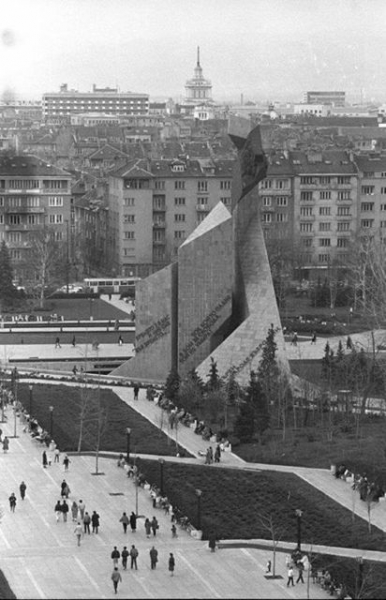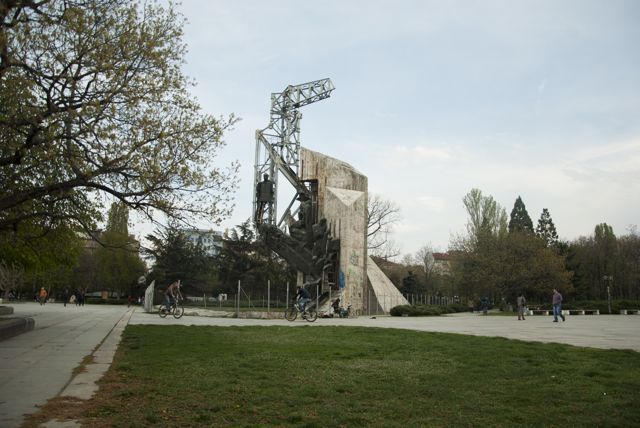Photos: Polina Spartyanova
Polina Spartyanova
"1300 years of Bulgaria" is an architectural complex in Sofia dedicated to the 1300th anniversary of the Bulgarian state. Its authors were Professor Valentin Starchev, architect Alexander Barov, architect Atanas Agura and engineer Milcho Brainov. The monument was built in a record eight months to culminate the opening of the National Palace of Culture at the end of March 1981 for the conduction of the XII Congress of the Bulgarian Communist Party. Probably because of the hasty works, it started running ten years later.
 The "1300 years of Bulgaria" monument is 35 metres high and the sculpture figures designed for it are 7 metres long. The composition itself is divided into three themes, namely past, present and future, and are represented by the literature, gratitude and creativity of the Bulgarian people. The contemporary, modern and abstract part is also divided into three large groups containing ascending blocks and ending with wings, a symbol of the stretch of thought, freedom of spirit and the irrepressible human desire for perfection.
The "1300 years of Bulgaria" monument is 35 metres high and the sculpture figures designed for it are 7 metres long. The composition itself is divided into three themes, namely past, present and future, and are represented by the literature, gratitude and creativity of the Bulgarian people. The contemporary, modern and abstract part is also divided into three large groups containing ascending blocks and ending with wings, a symbol of the stretch of thought, freedom of spirit and the irrepressible human desire for perfection.
The first figure of the composition, from bottom to top, is of the "scholars" and Tsar Simeon who represent Bulgaria’s golden age. The second one depicts a mother grieving for her children as a tribute to the fighters who died for the freedom of the country. The third is of the creative worker who is looking at the future of the People's Republic of Bulgaria.
Thoughts of Vasil Levski, "Time is in us and we are in time", Mihaylovski, "Go forth, people reborn" and of Hristo Botev, "He who dies in a fight for freedom never dies" were written on the other side of the monument. A few years ago, when the monument was safe-proofed against falling slabs, the bronze inscriptions were removed. Sofia Municipality has removed tons of iron from the crumbling monument and completely stripped it in order for it not to endanger the lives of passersby.
Since the monument is hollow inside and can be entered from the underground tunnels of Sofia, a homeless man has settled there who, according to the urban legend, is writing poetry inside the "1300 years of Bulgaria" monument to find comfort after the love of his life broke his heart.
Over the past 10 years the monument and its future has been at the centre of public debate. The poll conducted by Sofia Municipality in 2012 revealed that the majority of the capital's residents wanted the monument to be removed but that has not yet happened. Different ideas and projects for a new concept and vision of the monument have been discussed over the past two years but no final decision has been reached. In an interview for the state television, one of the creators of the monument, Professor Valentin Starchev, said, "We cannot erase the years of our history. And on top of that this monument and its compositions present in general 1300 years rather than a short regime that we have lived through."
After gathering all viewpoints regarding the future of the "1300 years of Bulgaria" monument, Sofia Municipal Council has has finally decided to announce a competition for its new vision. The jury will involve international representatives, and foreign architects and organizations will be invited to participate too. It is expected that the municipality will select by the summer several design projects for consideration in order to take action for the faster implementation of one of them.

Architect Pavel Popov makes an interesting summary of the historical situation and the importance of the monument in the context of the construction and transformation of the National Palace of Culture, "Today, the monument is a phenomenon just because a quarter-century after its creation, it more accurately represents what Bulgaria is, namely that it is swaggering, illogical, complacent, talkative, chaotic, confused as a construction and orientation, a self-destroying structure. Today the monument more accurately represents what it had to symbolize - a country that was free, for 100 years in legal terms and for 130 years in fact, to bring itself to that state the monument interprets today. I have always thought that the monument should be removed without much fuss or be drastically remade. Today, however, I think that, after taking the necessary precautions, the monument should be left as is, without any interference... until Bulgaria changes enough to merit another monument."
